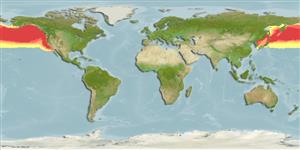Environment: milieu / climate zone / depth range / distribution range
Écologie
marin bathypélagique; profondeur 31 - 3400 m (Ref. 50550), usually 31 - 1189 m (Ref. 4925). Deep-water; 66°N - 29°N, 128°E - 113°W
North Pacific: Japan to Bering Sea and to northern Baja California, Mexico.
Taille / Poids / Âge
Maturity: Lm ? range ? - ? cm
Max length : 13.0 cm TL mâle / non sexé; (Ref. 2850); âge max. reporté: 8 années (Ref. 6885)
Épines dorsales (Total): 0; Rayons mous dorsaux (Total): 13-15; Épines anales 0; Rayons mous anaux: 14 - 16; Vertèbres: 35 - 38. Adipose fin small and slender; pectorals slender and short (Ref. 6885). Gray to dark greenish blue on dorsally, lighter ventrally; black on operculum and fins; golden or claret on photophores (Ref. 6885). Branchiostegal rays: 9-10 (Ref. 31442).
Epipelagic to mesopelagic (Ref. 31442). Adults move upward in large numbers at night (Ref. 28499). Feed on fishes, copepods and euphausiids (Ref. 11712). Oviparous, with planktonic eggs and larvae (Ref. 31442). Lipid content is 15.6 % in fresh body weight and wax ester is 90.9 % in total lipids (Ref. 9197). Minimum depth from Ref. 82347.
Eschmeyer, W.N., E.S. Herald and H. Hammann, 1983. A field guide to Pacific coast fishes of North America. Boston (MA, USA): Houghton Mifflin Company. xii+336 p. (Ref. 2850)
Statut dans la liste rouge de l'IUCN (Ref. 130435)
Menace pour l'homme
Harmless
Utilisations par l'homme
Outils
Articles particuliers
Télécharger en XML
Sources Internet
Estimates based on models
Preferred temperature (Ref.
123201): 0.9 - 7.4, mean 3.4 °C (based on 877 cells).
Phylogenetic diversity index (Ref.
82804): PD
50 = 0.7500 [Uniqueness, from 0.5 = low to 2.0 = high].
Bayesian length-weight: a=0.00955 (0.00414 - 0.02201), b=3.07 (2.86 - 3.28), in cm total length, based on LWR estimates for this species & (Sub)family-body (Ref.
93245).
Niveau trophique (Ref.
69278): 3.1 ±0.0 se; based on diet studies.
Résilience (Ref.
120179): Milieu, temps minimum de doublement de population : 1,4 à 4,4 années (K=0.24-0.34; tm=4; tmax=8).
Fishing Vulnerability (Ref.
59153): Low to moderate vulnerability (33 of 100).
Nutrients (Ref.
124155): Calcium = 67 [20, 203] mg/100g; Iron = 0.523 [0.197, 1.651] mg/100g; Protein = 16.9 [15.0, 18.7] %; Omega3 = 0.529 [0.179, 1.535] g/100g; Selenium = 16 [5, 48] μg/100g; VitaminA = 77.8 [10.3, 643.1] μg/100g; Zinc = 0.755 [0.380, 1.665] mg/100g (wet weight);
